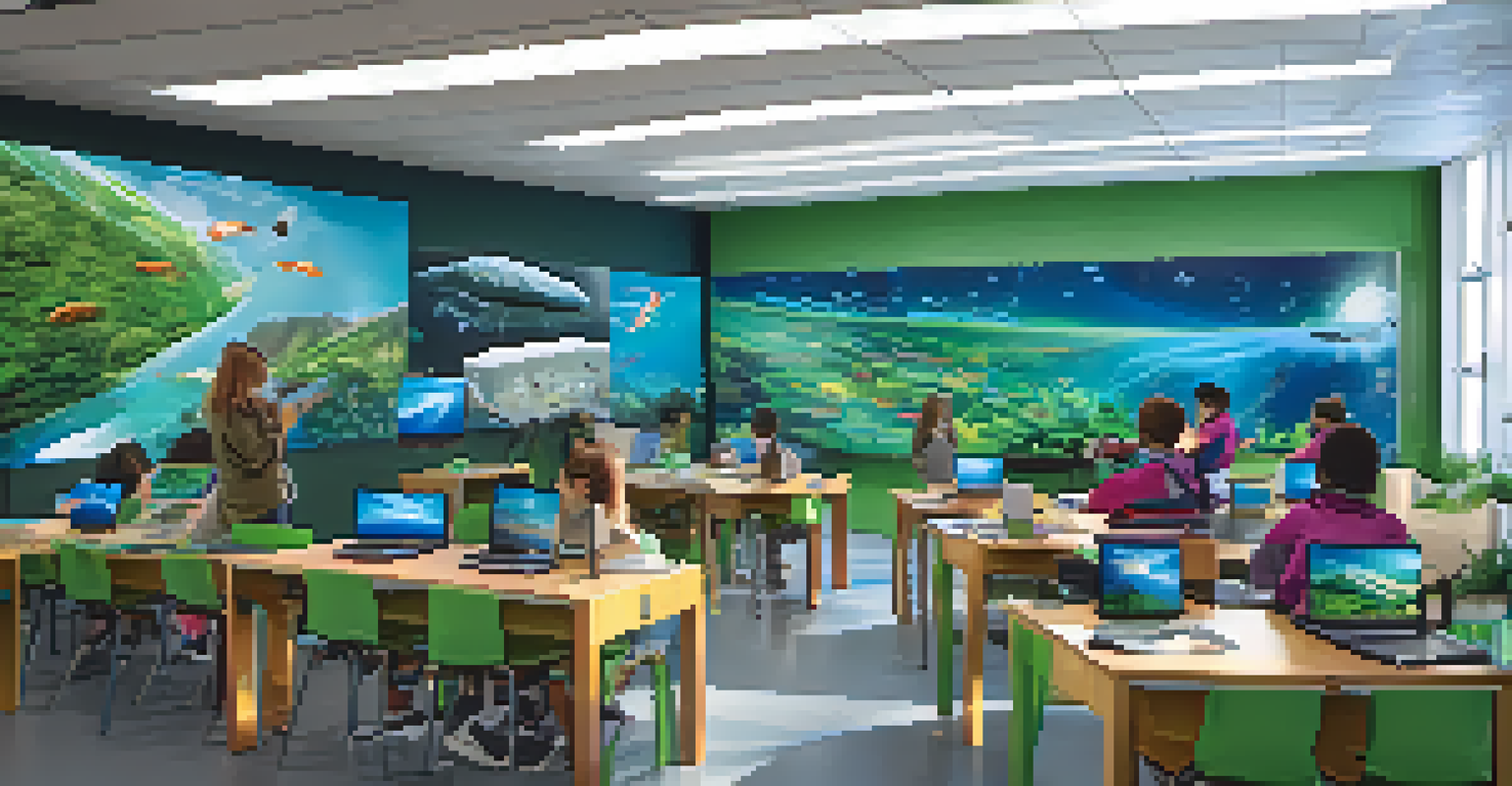STEAM Education and Environmental Sustainability

Understanding STEAM Education and Its Importance
STEAM stands for Science, Technology, Engineering, Arts, and Mathematics. This holistic approach encourages students to think critically and creatively, blending technical skills with artistic expression. By integrating these disciplines, STEAM education nurtures innovative problem-solving abilities, which are essential in today's rapidly changing world.
Education is the most powerful weapon which you can use to change the world.
One of the key benefits of STEAM education is its ability to engage diverse learners. For instance, a student who may struggle in traditional math classes might shine in an art project that incorporates mathematical concepts. This crossover not only boosts confidence but also demonstrates the interconnectedness of various fields, including environmental studies.
Moreover, STEAM education prepares students for future careers by emphasizing real-world applications. As industries increasingly seek professionals who can think across disciplines, equipping students with a STEAM mindset becomes vital for their success and for addressing global challenges, including environmental sustainability.
The Role of Environmental Sustainability in Education
Environmental sustainability focuses on meeting present needs without compromising future generations' ability to meet theirs. In education, this principle encourages students to think about their impact on the planet and the importance of preserving natural resources. Teaching sustainability helps students understand complex ecological systems and their roles within them.

Incorporating sustainability into education provides practical learning experiences. For example, students might participate in community clean-ups or create projects that promote recycling and conservation. These hands-on activities not only reinforce academic concepts but also foster a sense of responsibility and stewardship towards the environment.
STEAM Enhances Critical Thinking
By integrating science, technology, engineering, arts, and mathematics, STEAM education fosters innovative problem-solving and creative thinking skills.
Furthermore, sustainability education empowers students to become informed citizens. By exploring environmental issues and solutions, learners develop critical thinking skills that enable them to engage in meaningful discussions and advocate for positive change in their communities.
Integrating Sustainability into STEAM Curriculum
Integrating sustainability into the STEAM curriculum can be both innovative and enjoyable. Teachers can design projects that challenge students to create sustainable solutions, such as building solar-powered devices or developing apps to monitor energy consumption. This approach not only teaches technical skills but also instills a sense of environmental awareness.
The greatest threat to our planet is the belief that someone else will save it.
Project-based learning is a highly effective method for merging STEAM and sustainability. For example, students might work on an interdisciplinary project where they design a community garden, considering ecological principles while applying mathematical calculations for layout and resource management. This experiential learning fosters collaboration and critical thinking.
Additionally, educators can invite guest speakers from environmental organizations to share their expertise. This real-world connection enriches the learning experience and inspires students to envision their potential contributions to sustainability efforts.
Benefits of STEAM Education for Environmental Challenges
STEAM education equips students with the tools to tackle pressing environmental challenges. By fostering creativity and innovation, students are encouraged to think outside the box when proposing solutions to issues like climate change or pollution. This mindset is crucial for developing new technologies and practices that can mitigate environmental impacts.
Collaboration is another significant benefit of STEAM education in addressing environmental issues. Students often work in teams, combining their unique skills and perspectives to brainstorm and implement solutions. This collaborative spirit mirrors real-world environmental initiatives, where diverse stakeholders must come together to effect change.
Sustainability Empowers Students
Incorporating sustainability into the curriculum encourages students to understand their environmental impact and promotes responsible citizenship.
Moreover, by engaging in projects focused on environmental sustainability, students cultivate a sense of agency. They learn that their actions, both individually and collectively, can contribute to a healthier planet, fostering a generation of environmentally conscious leaders.
Real-World Examples of STEAM and Sustainability
Many schools and organizations are successfully combining STEAM education with sustainability initiatives. For instance, some institutions have integrated sustainability into their science curriculum by conducting experiments on renewable energy sources. This hands-on experience not only enhances scientific understanding but also highlights the importance of sustainable practices.
Another example is the use of technology in promoting environmental awareness. Students can develop apps that track energy usage or create websites that educate peers about local environmental issues. These projects empower students to use their technological skills for a greater purpose, reinforcing the relevance of their education.
Additionally, programs like Robotics for Good encourage students to design robots that tackle environmental problems, such as cleaning up oceans or monitoring wildlife. These initiatives demonstrate the tangible impact that STEAM education can have on sustainability efforts, inspiring students to engage actively with their communities.
Challenges in Merging STEAM and Sustainability
While the integration of STEAM education and sustainability is promising, there are challenges to overcome. One significant hurdle is the lack of resources and training for educators. Many teachers may feel unprepared to teach sustainability concepts within the STEAM framework, which can hinder effective implementation.
Another challenge is ensuring that sustainability education remains relevant and engaging. With rapidly changing environmental issues, it's crucial to keep the curriculum updated and aligned with current trends. This requires ongoing professional development for educators to stay informed and inspired.
Real-World Applications Drive Learning
Project-based learning that connects STEAM with sustainability equips students with practical skills to address real environmental challenges.
Finally, schools must also find ways to measure the impact of STEAM and sustainability initiatives. Assessing student learning and engagement can be complex, but establishing clear metrics is essential for understanding the effectiveness of these programs and securing support for future initiatives.
The Future of STEAM Education and Environmental Sustainability
The future of STEAM education in relation to environmental sustainability looks promising. As awareness of climate change and ecological issues continues to grow, educational institutions are increasingly prioritizing these subjects within their curricula. This shift prepares students to face the challenges of tomorrow with confidence and creativity.
Innovative technologies, such as virtual reality and artificial intelligence, are likely to play a significant role in shaping STEAM education. These tools can provide immersive learning experiences, allowing students to explore ecosystems or simulate environmental scenarios. Such advancements will make sustainability education more engaging and interactive.

Ultimately, the fusion of STEAM education and environmental sustainability fosters a generation of thinkers and doers who are not only equipped with knowledge but also driven by a passion for creating a better world. As they step into their futures, these students will be instrumental in leading the charge toward a more sustainable planet.